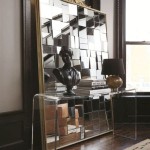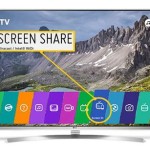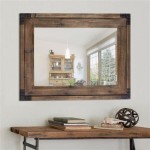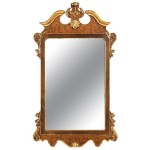Flat Screen TV That Turns Into a Mirror: A Technological Convergence
The integration of entertainment and interior design is a growing trend, with manufacturers constantly seeking innovative ways to blend technology seamlessly into our living spaces. One compelling result of this pursuit is the development of flat-screen televisions that transform into mirrors when not in use. These devices offer a unique solution for individuals seeking to optimize space, reduce visual clutter, and maintain a sophisticated aesthetic within their homes.
The concept leverages advancements in display technology, reflective coatings, and smart home integration to create a product that serves dual purposes. It caters to a consumer base that prioritizes both functionality and style, offering a high-quality television viewing experience alongside the visual appeal of a decorative mirror. This convergence of technology and design has the potential to redefine how we interact with media within our homes.
Key Technological Components Enabling the Transformation
The ability of a flat-screen television to morph into a mirror hinges on a combination of several sophisticated technological advancements. These components work in concert to deliver a convincing mirror reflection while maintaining the performance of a high-definition display.
The core of this technology rests on the principle of selectively reflecting and transmitting light. Standard mirrors utilize a reflective coating applied to the back of a glass substrate. However, this coating is opaque, preventing any light from passing through it. This system is incompatible with the operation of a television display which requires light to actively emit from its pixels.
Manufacturers have addressed this challenge by employing beam splitter technology, often in conjunction with specialized optical coatings. A beam splitter is a partially reflective mirror that splits an incident beam of light into two separate beams. One beam is reflected, while the other is transmitted. When used in a mirror TV, the coating is designed to reflect a significant portion of ambient light, creating the appearance of a mirror. Simultaneously, it allows the light generated by the underlying display panel to pass through, enabling the television to function normally.
The choice of display panel technology is also crucial. OLED (Organic Light Emitting Diode) displays are frequently preferred for mirror TVs due to their inherent properties. OLEDs are self-emissive, meaning each pixel generates its own light. This eliminates the need for a backlight, which is present in traditional LCD (Liquid Crystal Display) televisions. The absence of a backlight contributes to a thinner profile and improved contrast, both of which enhance the mirror's reflectivity and the overall visual clarity of the television image. The reduction in layers between the viewer and the projected light also creates a more uniform mirroring effect.
Furthermore, sophisticated image processing techniques are employed to optimize the picture quality of the television when it is in use. These algorithms compensate for any distortions or color shifts that may be introduced by the reflective coating. Features such as dynamic contrast enhancement and color calibration are utilized to ensure that the viewing experience is uncompromised.
The outer frame and construction of the TV also play a significant role. Premium materials and streamlined designs are utilized to complement the dual functionality. Often, the frames are designed to be minimalist, drawing less attention to the edges of the television and allowing the mirroring effect to dominate when the display is off. The overall design contributes to the aesthetic integration of the television into the surrounding environment.
Applications and Benefits of Mirror TVs
The applications for mirror TVs are diverse, extending beyond simply concealing a television. Their unique blend of functionality and aesthetics makes them suitable for various environments and purposes.
In residential settings, mirror TVs offer a space-saving solution, particularly in areas where wall space is limited. Small apartments, bathrooms, and bedrooms can benefit from the dual functionality, allowing homeowners to enjoy entertainment without sacrificing valuable real estate. The mirror also contributes to the perceived size of the room, making it feel larger and more open.
Designers often incorporate mirror TVs into luxury homes and high-end interiors, utilizing them as decorative elements that seamlessly integrate with the overall aesthetic. The mirror can be framed as a statement piece, blending seamlessly into existing decor or serving as a focal point within the space. Custom framing options further enhance the personalization of the design, allowing homeowners to tailor the appearance of the mirror TV to their specific preferences.
Commercial environments also present viable applications for these devices. Hotels, spas, and gyms can integrate mirror TVs into their facilities to provide entertainment and information to their guests without compromising the ambiance. For instance, a mirror TV in a hotel bathroom can offer news updates, weather forecasts, or room service menus, enhancing the guest experience. Similarly, gyms can use mirror TVs to display workout routines or promotional material, seamlessly integrating technology into the exercise environment.
Beyond space-saving and aesthetics, mirror TVs offer practical benefits. They can be integrated into smart home systems, enabling voice control and automation. Users can turn the television on or off, adjust the volume, or change channels using voice commands, adding convenience and accessibility to their entertainment experience. The mirroring feature also offers convenience for everyday tasks, such as checking one's appearance or applying makeup.
Security is another potential application. Mirror TVs can be integrated with security cameras, displaying live video feeds when triggered by motion detection. This allows homeowners to discreetly monitor their property without the overt presence of security equipment. The mirroring effect provides a layer of camouflage, making it difficult for intruders to identify the hidden camera.
Challenges and Future Developments in Mirror TV Technology
Despite the advancements in mirror TV technology, certain challenges remain. These challenges primarily revolve around optimizing the reflectivity of the mirror while maintaining the brightness and clarity of the television display. Balancing these two competing requirements requires continued innovation in materials science and image processing.
Currently, the reflectivity of mirror TVs is generally lower than that of traditional mirrors. This can result in a slightly darker or less vibrant reflection, especially in dimly lit environments. Manufacturers are actively researching new coatings and beam splitter designs to improve the reflectivity without compromising the performance of the display. Nanomaterials and advanced optical coatings are being explored to achieve higher levels of reflection while minimizing light absorption.
Another challenge lies in mitigating glare and reflections on the screen when the television is in use. Ambient light can interfere with the viewing experience, particularly in brightly lit rooms. Anti-glare coatings and display technologies are being developed to reduce these effects and improve visibility. These coatings selectively absorb or diffuse ambient light, minimizing reflections and enhancing contrast. However, these coatings need to be applied without affecting the mirroring property when the display is turned off.
The cost of mirror TVs is currently higher than that of conventional flat-screen televisions. This is due to the specialized materials and manufacturing processes involved. As demand increases and production techniques are refined, the cost is expected to decrease, making mirror TVs more accessible to a wider range of consumers. Standardization of components and streamlined manufacturing processes will contribute to cost reductions.
Future developments in mirror TV technology are likely to focus on enhancing the integration of artificial intelligence (AI) and augmented reality (AR). AI-powered features could personalize the viewing experience, suggesting content based on user preferences and viewing habits. AR applications could overlay digital information onto the mirror image, providing users with interactive experiences. For example, a mirror TV could display weather information, news headlines, or social media updates alongside the reflection.
Flexible displays are another area of potential development. Flexible mirror TVs could be integrated into curved surfaces or unconventional spaces, offering new design possibilities. These displays could be rolled up or folded away when not in use, maximizing space and flexibility. The development of durable and scalable flexible display technology is essential for realizing this vision.
In conclusion, the integration of television and mirror technologies represents a significant step forward in the convergence of entertainment and interior design. The unique combination of functionality and aesthetics makes mirror TVs a compelling option for individuals seeking to optimize space, reduce visual clutter, and enhance the sophistication of their living environments. Continued innovation in display technology, optical coatings, and smart home integration will further enhance the capabilities and applications of these devices, solidifying their position as a prominent element in modern homes and commercial spaces.

75 Framed Samsung Led Mirror Tv Model Un75ju641

Samsung Mirror Tv Design Your Perfect Framed Dielectric

Eclipse Tv Cover By Electric Mirror Tvc 55 Emr615298

Samsung Led Transition Mirror Tv

Samsung Mirror Tv Complete Guide For 2024 Models

Mirror Covered Tv They Should Make Tvs That Look Like Mirrors With Ornate Frames Until You Turn It On Cool Framed Over Fireplace Living Room Wall

Mirror Tv High Quality Digital Television With Interactivity

Mirror Tv Television Pro Display

Mirror Tv High Quality Digital Television With Interactivity

Samsung Mirror Tv Complete Guide For 2024 Models








